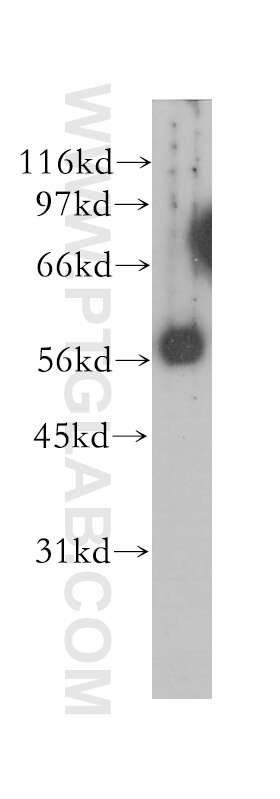CCT6B Polyklonaler Antikörper
CCT6B Polyklonal Antikörper für WB, ELISA
Wirt / Isotyp
Kaninchen / IgG
Getestete Reaktivität
human, Maus, Ratte
Anwendung
WB, ELISA
Konjugation
Unkonjugiert
Kat-Nr. : 12628-1-AP
Synonyme
Galerie der Validierungsdaten
Geprüfte Anwendungen
| Erfolgreiche Detektion in WB | Maus-Eierstockgewebe |
Empfohlene Verdünnung
| Anwendung | Verdünnung |
|---|---|
| Western Blot (WB) | WB : 1:500-1:2000 |
| It is recommended that this reagent should be titrated in each testing system to obtain optimal results. | |
| Sample-dependent, check data in validation data gallery | |
Veröffentlichte Anwendungen
| WB | See 1 publications below |
Produktinformation
12628-1-AP bindet in WB, ELISA CCT6B und zeigt Reaktivität mit human, Maus, Ratten
| Getestete Reaktivität | human, Maus, Ratte |
| In Publikationen genannte Reaktivität | human |
| Wirt / Isotyp | Kaninchen / IgG |
| Klonalität | Polyklonal |
| Typ | Antikörper |
| Immunogen | CCT6B fusion protein Ag3321 |
| Vollständiger Name | chaperonin containing TCP1, subunit 6B (zeta 2) |
| Berechnetes Molekulargewicht | 530 aa, 58 kDa |
| Beobachtetes Molekulargewicht | 58 kDa |
| GenBank-Zugangsnummer | BC027591 |
| Gene symbol | CCT6B |
| Gene ID (NCBI) | 10693 |
| Konjugation | Unkonjugiert |
| Form | Liquid |
| Reinigungsmethode | Antigen-Affinitätsreinigung |
| Lagerungspuffer | PBS mit 0.02% Natriumazid und 50% Glycerin pH 7.3. |
| Lagerungsbedingungen | Bei -20°C lagern. Nach dem Versand ein Jahr lang stabil Aliquotieren ist bei -20oC Lagerung nicht notwendig. 20ul Größen enthalten 0,1% BSA. |
Hintergrundinformationen
CCT6B, also named as CCT-zeta-2, TCP-1-zeta-like, CCT-zeta-like, testis-specific Tcp20 and testis-specific protein TSA303, belongs to the TCP-1 chaperonin family. CCT6B is a molecular chaperone which assists the folding of proteins upon ATP hydrolysis. It is known to play a role in vitro, in the folding of actin and tubulin. This antibody can recognize both of CCT6A and CCT6B.
Publikationen
| Species | Application | Title |
|---|---|---|
Mol Oral Microbiol Antigenic group II chaperonin in Methanobrevibacter oralis may cross-react with human chaperonin CCT. |


